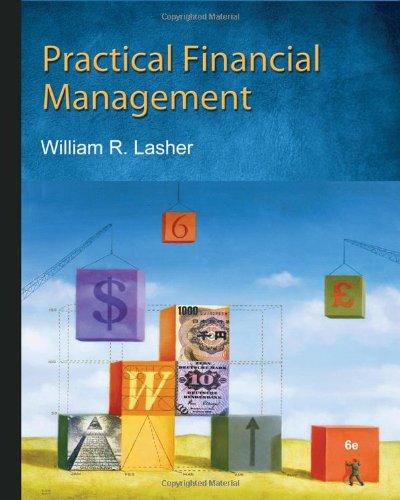Question
Once the ratio analysis is completed answer the following questions.... Here is the ratio analysis for Disney, please answer the following questioned based off this
Once the ratio analysis is completed answer the following questions.... Here is the ratio analysis for Disney, please answer the following questioned based off this analysis. Please answer in paragraph form.
Disney Profitability Ratios
Year 2012
Return on equity = Net income after tax Common stockholders equity
6,173,000 39,759,000 = .16
Return on assets = Net income after tax total assets
6,173,000 74,898,000 = .08
Gross profit margin = Sales Cost of goods sold Sales
42,278,000 23,468,000 = 18,810,000
18,810,000 42,278,000 = .44
Operating profit margin = Operating profits sales
Operating profit is total sales total expenses
42,278,000- (33,415,000) = 8,863,000
8863 42,278,000 = .21
Net profit margin = Net income after tax sales
6,173,000 42,278,000 = .15
Year 2013
Return on equity = Net income after tax Common stockholders equity
6,636,000 45,429,000 = .15
Return on assets = Net income after tax total assets
6,636,000 81,241,000 = .08
Gross profit margin = Sales Cost of goods sold Sales
45,041,000 25,034,000 = 20,007,000
20,007,000 45,041,000 = .44
Operating profit margin = Operating profits sales
Operating profit is total sales total expenses
45,041,000 - (35,591,000) = 9,450,000
9,450,000 45,041,000 = .21
Net profit margin = Net income after tax sales
6,636,000 45,041,000 = .15
Year 2014
Return on equity = Net income after tax Common stockholders equity
8,004,000 44,958,000 = .18
Return on assets = Net income after tax total assets
8,004,000 84,186,000 = .10
Gross profit margin = Sales Cost of goods sold Sales
48,813,000 26,420,000 = 22,393,000
22,393,000 48,813,000 = .46
Operating profit margin = Operating profits sales
Operating profit is total sales total expenses
48,813,000 - (37,273,000) = 11,540,000
11,540,000 48,813,000 = .24
Net profit margin = Net income after tax sales
8,004,000 48,813,000 = .16
Disney Liquidity Ratios
Year 2012
Current ratio = current assets current liabilities
13,709,000 12,813,000 = 1.07
Quick Ratio = Current assets Inventory Current liabilities
13,709,000 1,537,000 = 12,172,000
12,172,000 12,813,000 = .95
Year 2013
Current ratio = current assets current liabilities
14,109,000 11,704,000 = 1.21
Quick Ratio = Current assets Inventory Current liabilities
14,109,000 1,487,000 = 12,622,000
12,622,000 11,704,000 = 1.08
Year 2014
Current ratio = current assets current liabilities
15,176,000 13,292,000 = 1.14
Quick Ratio = Current assets Inventory Current liabilities
15,176,000 1,574,000 = 13,602,000
13,602,000 13,292,000 = 1.02
Disney Activity Ratios
Year 2012
Inventory Turnover: Cost of Goods sold= $23,347 (million) Inventory=$2,213 (million)
23347/.6
Inventory Turnover: Cost of Goods sold=$23,468 (million)/Inventory $1,537 (million) .3
Accounts Receivables Turnover: Sales= $ 42,278(million) Accounts Receivable = $6,540(million)
42278/.5
Total Asset Turnover: Sales=$42,278(million) Total Assets= $74,898 (million)
42,278/74,898=.6
Average Collection Period: Receivables Turnover= 6.5
365/6. days
Year 2013
Inventory Turnover: Cost of Goods sold= $23,347(million) Inventory= $2,121(million)
23347/.0
25,034/.8
Accounts Receivables Turnover: Turnover: Sales= $45,041(million) Accounts Receivable =$ 6,967(million)
45041/.5
Total Asset Turnover: Sales=$45,041(million) Total Assets=$81,241 (million)
45041/.6
Average Collection Period: Receivables .5
365/6. days
Year 2014
Inventory Turnover: Cost of Goods sold= $26,420 (million) Inventory=$2,635(million)
$1,574(million)
26420/2,.0
26420/1,.8
Accounts Receivables Turnover: Turnover: Sales= $48,813(million) Accounts Receivable =$9,043(million)
$7,822(million)
48813/.4
48813/.2
Total Asset Turnover: Sales= $48,813 (million) Total Assets= $84,186 (million)
48813/.6
Average Collection Period: Receivables .4
365/5. days
Disney Market Ratios
Year 2012
EPS: Net income Available to common stockholders= $5,682,000 number of shares outstanding .839 (million)
5682000/.1
PS: Market price of common .6 Earnings per .1
PE VS PS 52.6/3..0
Market to Book: Market Value per share= $49.15 Book Value per Share=$22.09
49.15/22..22
Year 2013
EPS: Net income Available to common stockholders= $6,136,000 number of shares outstanding .8 (million)
6136000/.4
PS: Market price of common .7 Earnings per .4
PE VS PS 64.7/3..0
Market to Book: Market Value per share= 74.35 Book Value per .24
74.35/25..95
Year 2014
EPS: Net income Available to common stockholders=$7,501,000 number of shares outstanding .7 (million)
7501000/.4
PS: Market price of common stock= 89.7 Earnings per .4
PE VS PS 89.7/4..4
Market to Book: Market Value per share=$92.89 Book Value per Share=$26.45
92.89/26..51
**1. Does the firm have any problem areas that you would investigate further if you were a manager?
**2. Are there any other specific pieces of information that you would request from your management team with regards to this firm? If so, why?
**3. Would you invest money in this firm based on your analysis
Step by Step Solution
There are 3 Steps involved in it
Step: 1

Get Instant Access to Expert-Tailored Solutions
See step-by-step solutions with expert insights and AI powered tools for academic success
Step: 2

Step: 3

Ace Your Homework with AI
Get the answers you need in no time with our AI-driven, step-by-step assistance
Get Started


